超声波检测培训资料
超声波检测专题知识讲座培训课件

X
联合双探头 (分割探头)
FG
水浸探头
SJ
瑞利波(表面 波)探头
可变角探头
超声波检测专题知识讲座
BM
KB
39
超声波探头
▪ 探头与仪器的连接
▪ 为了消除外来电波对探头的激励脉冲及回波脉冲 产生影响,探头须用同轴高频电缆。注意事项如 下:
▪ 对于用石英、硫酸锂等压电晶片所制成的探头,不能 任意配用非规定的(长度、种类)电缆。
超声波检测专题知识讲座
10
超声波检测仪
A型显示超声仪
超声波检测专题知识讲座
11
CTS-22
仪器抗干扰能力强、分辨率高、操作简单
超声波检测专题知识讲座
12
CTS-9002
入门级数字探伤 仪,性能价格比 高、操作简单、 低温性能优越, 适合大多数无损 检测场合使用。
超声波检测专题知识讲座
13
CTS-9003
超声波检测专题知识讲座
26
超声波检测仪
发射部分 接收部分 时间轴部分
A超声仪基 本组成
示波管 电源部分 辅助电路
超声波检测专题知识讲座
27
超声波检测仪
发射部分
发射部分能产生约500V以上的高压电脉冲,这个电脉冲加到 (探头的)压电晶片上(使晶片产生振荡,其振荡频率超过 20KHz)能使晶片发出超声波。
• 横波斜探头主要用于探测与探测面成一定角度的平面型及立 方体型缺陷,应用广泛。
▪ 接触式聚焦探头:
• 接触式聚焦探头可分为三类:透镜式、反射式和曲面晶片式。
超声波检测专题知识讲座
37
超声波探头
探
基本频率: 用阿拉伯数字表示,单位为MHz
头
超声波探伤讲义(内部培训资料)
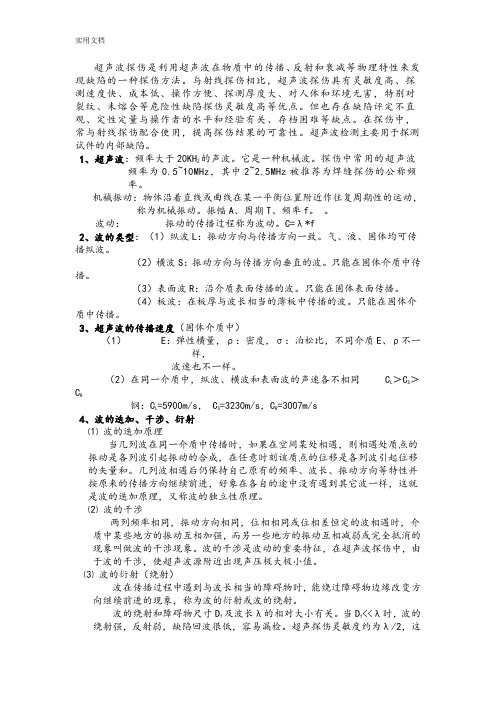
超声波探伤是利用超声波在物质中的传播、反射和衰减等物理特性来发现缺陷的一种探伤方法。
与射线探伤相比,超声波探伤具有灵敏度高、探测速度快、成本低、操作方便、探测厚度大、对人体和环境无害,特别对裂纹、未熔合等危险性缺陷探伤灵敏度高等优点。
但也存在缺陷评定不直观、定性定量与操作者的水平和经验有关、存档困难等缺点。
在探伤中,常与射线探伤配合使用,提高探伤结果的可靠性。
超声波检测主要用于探测试件的内部缺陷。
1、超声波:频率大于20KHZ的声波。
它是一种机械波。
探伤中常用的超声波频率为0.5~10MHz,其中2~2.5MHz被推荐为焊缝探伤的公称频率。
机械振动:物体沿着直线或曲线在某一平衡位置附近作往复周期性的运动,称为机械振动。
振幅A、周期T、频率f。
波动:振动的传播过程称为波动。
C=λ*f2、波的类型:(1)纵波L:振动方向与传播方向一致。
气、液、固体均可传播纵波。
(2)横波S:振动方向与传播方向垂直的波。
只能在固体介质中传播。
(3)表面波R:沿介质表面传播的波。
只能在固体表面传播。
(4)板波:在板厚与波长相当的薄板中传播的波。
只能在固体介质中传播。
3、超声波的传播速度(固体介质中)(1) E:弹性横量,ρ:密度,σ:泊松比,不同介质E、ρ不一样,波速也不一样。
(2)在同一介质中,纵波、横波和表面波的声速各不相同 CL >CS>C R钢:CL =5900m/s, CS=3230m/s,CR=3007m/s4、波的迭加、干涉、衍射⑴波的迭加原理当几列波在同一介质中传播时,如果在空间某处相遇,则相遇处质点的振动是各列波引起振动的合成,在任意时刻该质点的位移是各列波引起位移的矢量和。
几列波相遇后仍保持自己原有的频率、波长、振动方向等特性并按原来的传播方向继续前进,好象在各自的途中没有遇到其它波一样,这就是波的迭加原理,又称波的独立性原理。
⑵波的干涉两列频率相同,振动方向相同,位相相同或位相差恒定的波相遇时,介质中某些地方的振动互相加强,而另一些地方的振动互相减弱或完全抵消的现象叫做波的干涉现象。
超声波探伤培训教程

超声波探伤培训教程超声波探伤技术是一种通过超声波在材料内部传播和反射的方式来检测材料中存在的缺陷或者异物的非破坏性检测技术。
在工业领域得到了广泛应用,尤其是在航空、航天、核能、石油等行业。
本教程将系统介绍超声波探伤的原理、设备以及操作技巧,帮助读者全面了解和掌握超声波探伤技术。
一、原理1. 超声波的生成和传播超声波是指频率超过20kHz的声波。
其生成通常是通过压电晶体的压电效应来实现,当施加电压时,压电晶体会振动并产生超声波。
超声波在材料中的传播是一种机械波的传播方式,它具有直线传播、可传递到深层、能量损失小等特点。
2. 超声波的反射和散射当超声波遇到材料中的缺陷或者界面时,会发生反射和散射。
根据反射和散射的信号,可以判断材料中的缺陷类型、位置、尺寸等信息。
常用的探伤方法包括脉冲回波法和相位数组法。
二、设备1. 超声波探伤仪超声波探伤仪是进行超声波探伤的核心设备,它包括发射装置、接收装置、信号处理系统等部分。
发射装置用于产生超声波信号,接收装置用于接收反射和散射的信号,信号处理系统则对接收到的信号进行处理和显示。
2. 探头探头是超声波探伤仪的重要部件,其质量和性能直接影响到探伤的效果。
常见的探头类型有直探头、斜探头、浸润式探头等。
不同类型的探头适用于不同的检测对象和环境。
三、操作技巧1. 检测准备在进行超声波探伤之前,需要对设备和探头进行校准和检查,确保其正常工作。
同时,还需要根据待检测材料的类型和要求选择合适的探头,并对材料表面进行清洁和处理。
2. 检测步骤(1)将探头与被检测材料紧密接触,确保超声波能够传播到材料内部。
(2)调节探测范围和增益,以保证检测到的信号具有足够的强度。
(3)进行扫描或者点检测,记录检测到的信号并分析。
(4)根据检测结果判断材料的质量,如果发现缺陷,需进一步分析和评估。
四、应用案例超声波探伤技术在各个行业都有广泛的应用。
以下是几个实际案例:1. 航空领域在航空器制造和维修过程中,通过超声波探伤可以检测飞机结构中的隐蔽缺陷,如裂纹、孔洞等。
5、2013年超声波桩基检测技术培训
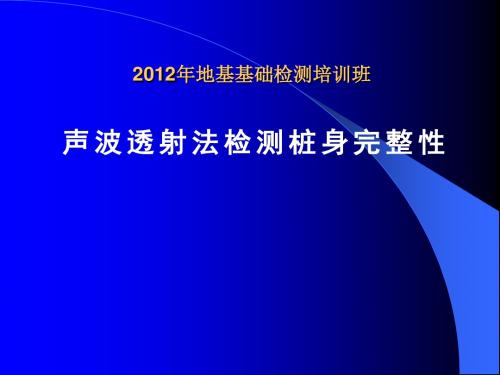
所以入射角等于反射角(i=β )。
折射定律:入射角(i)的正弦与折射角(θ )
的正弦之比等于入射波与折射波速度之比,即:
Sini v1
Sin v2
(1.16)
图1-11 流体界面上声波的反射与折射 图1-12 固体界面上声波的反射与折射
以上情况可以在流体(气体、液体)的分 界面看到。在这种情况下,介质中只有单一的 波-纵波出现。
增大入射波的入射角,则折射波的折射角亦随之
增大。如果入射波是纵波,且ν 1p<ν 2p则由(1.15)
式可知,θ p>ip,即折射角大于入射角。当ip增大,
θ p也增大,当θ p=90°时,此时的入射角叫第一临 界角,用符号i 1;表示。显然,当入射角大于第一 临界角时,第二种介质中只有折射横波存在,如图
在固体介质分界面的情况则复杂一些。当 一种波(例如纵波)入射到固体分界面时,不 仅波方向发生变化且波型也发生变化,分离为 反射纵波、反射横波,折射纵波和折射横波。 各类波的传播方向(即反射角与折射角)各不 相同,如图1-12所示。
各种类型波的传播方向的变化亦符合几何光 学中的反射定律和折射定律。其数学表达式如 下:
鉴于目前高重建筑、公路桥梁工程大量使用大 直径桩和超长桩,该方法将越来越多的使用在基桩 的检测中。
分四个部分讲解:
声学理论 检测技术 测试方法 工程实例
第一部分 基本原理
波动与声波的概念 声波在介质中的传播速度 声波在介质界面上的反射与透射 声波在传播过程中的衰减 混凝土中的声波特性
固体材料中声波衰减主要有以下几个方面的原因: (1)吸收衰减:声波在固体介质中传播时,由于介质的粘滞 性而造成质点之间的内摩擦,从而使一部分声能转变为热能。 (2)散射衰减:当介质中存在颗粒状结构(如固体介质中的 颗粒、缺陷、掺杂物等)而导致声波能量的衰减。如在混凝土 中一方面其中的粗骨料构成许多声学界面,使声波在这些界面 上产生多次反射、折射和波型转换;另一方面微小颗粒在超声 波的作用下产生新的震源,向四周发射声波,使声波能量的扩 散到达最大。 (3)扩散衰减:声波发射器发出的超声波束都有一定的扩散 角。波束的扩散,导致能量的逐渐分散,从而使单位面积的能 量随传播距离的增加而减弱。
无损检测超声波二级培训教材

这样一个完整运动过程称为一个“循环”或叫一次“全振 动”。 每经过一定时间后,振动体总是回复到原来的状态 或位置 的振动称为周期性振动,不具有上述周期性规律的振动称 为非周期性振动。
10
振动是往复的运动,振动的快慢常用振动周期和振动频率 两个物理量来描述。振动的强弱用振幅来表征。
周期:当物体作往复运动时完成一次全振动所需的时间, 称为振动周期,用 T 表示。常用单位为秒 s 。
5
1. 是否存在来自缺陷的超声信号及其幅度; 2. 回波的传播时间; 3. 超声波通过材料后的能量衰减。
6
第2章 超声波探伤的物理基础 超声波是一种机械波,是机械振动在介质中的传播。 机械振动与波动是超声波探伤的物理基础。 超声波探伤中,主要涉及到几何声学和物理声学中的一些 基本定律和概念。 如几何声学中的反射、折射定律及波型转换; 物理声学中波的叠加、干涉、衍射等。
23
2.阻尼振动:谐振动是理想条件下的振动,不考虑摩擦和 其它阻力的影响。但任何实际物体的振动,总要受到阻力 的作用。由于要克服阻力做功,则振动物体的能量不断减 少。这种振幅或能量随时间不断减少的振动,称为阻尼振 动。
24
3.受迫振动:物体受到周期性变化的外力作用时,产生的 振动。
受迫振动刚开始时情况很复杂,经过一段时间后达到稳定 状态,变为周期性的谐振动。其振动频率与策动力频率相 同,振幅保持不变。
波动中介质各质点并不随波前进,而是按照与波源相同的 振动频率在各自的平衡位置上振动,并将能量传递给周围 的质点。
这种能量的传播,不是靠物质的迁移来实现的,也不是靠相 邻质点的弹性碰撞来完成的,而是由各质点的位移连续变 化来逐渐传递出去的 。
因此,机械波的传播不是物质的传播,而是振动状态和能量 的传播。
超声波无损检测培训

培训教材之理论基础第一章无损检测概述无损检测包括射线检测(RT)、超声检测(UT)、磁粉检测(MT)、渗透检测(PT)和涡流检测(ET)等五种检测方法。
主要应用于金属材料制造的机械、器件等的原材料、零部件和焊缝,也可用于玻璃等其它制品。
射线检测适用于碳素钢、低合金钢、铝及铝合金、钛及钛合金材料制机械、器件等的焊缝及钢管对接环缝。
射线对人体不利,应尽量避免射线的直接照射和散射线的影响。
超声检测系指用A型脉冲反射超声波探伤仪检测缺陷,适用于金属制品原材料、零部件和焊缝的超声检测以及超声测厚。
磁粉检测适用于铁磁性材料制品及其零部件表面、近表面缺陷的检测,包括干磁粉、湿磁粉、荧光和非荧光磁粉检测方法。
渗透检测适用于金属制品及其零部件表面开口缺陷的检测,包括荧光和着色渗透检测。
涡流检测适用于管材检测,如圆形无缝钢管及焊接钢管、铝及铝合金拉薄壁管等。
磁粉、渗透和涡流统称为表面检测。
第二章超声波探伤的物理基础第一节基本知识超声波是一种机械波,机械振动与波动是超声波探伤的物理基础。
物体沿着直线或曲线在某一平衡位置附近作往复周期性的运动,称为机械振动。
振动的传播过程,称为波动。
波动分为机械波和电磁波两大类。
机械波是机械振动在弹性介质中的传播过程。
超声波就是一种机械波。
机械波主要参数有波长、频率和波速。
波长?:同一波线上相邻两振动相位相同的质点间的距离称为波长,波源或介质中任意一质点完成一次全振动,波正好前进一个波长的距离,常用单位为米(m);频率f:波动过程中,任一给定点在1秒钟内所通过的完整波的个数称为频率,常用单位为赫兹(Hz);波速C:波动中,波在单位时间内所传播的距离称为波速,常用单位为米/秒(m/s)。
由上述定义可得:C=? f ,即波长与波速成正比,与频率成反比;当频率一定时,波速愈大,波长就愈长;当波速一定时,频率愈低,波长就愈长。
次声波、声波和超声波都是在弹性介质中传播的机械波,在同一介质中的传播速度相同。
超声波检测培训计划
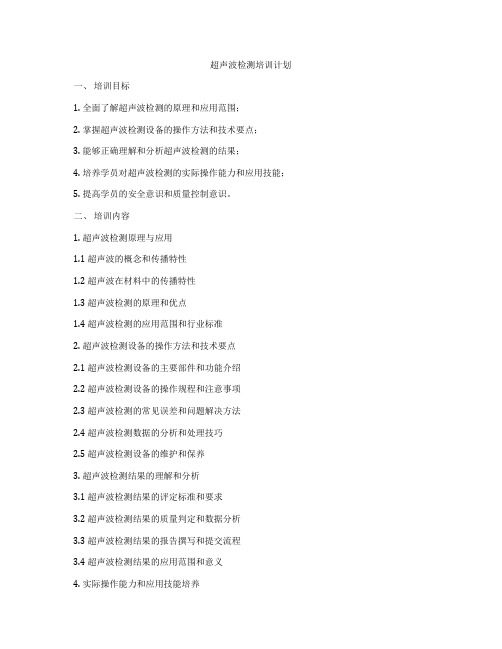
超声波检测培训计划一、培训目标1. 全面了解超声波检测的原理和应用范围;2. 掌握超声波检测设备的操作方法和技术要点;3. 能够正确理解和分析超声波检测的结果;4. 培养学员对超声波检测的实际操作能力和应用技能;5. 提高学员的安全意识和质量控制意识。
二、培训内容1. 超声波检测原理与应用1.1 超声波的概念和传播特性1.2 超声波在材料中的传播特性1.3 超声波检测的原理和优点1.4 超声波检测的应用范围和行业标准2. 超声波检测设备的操作方法和技术要点2.1 超声波检测设备的主要部件和功能介绍2.2 超声波检测设备的操作规程和注意事项2.3 超声波检测的常见误差和问题解决方法2.4 超声波检测数据的分析和处理技巧2.5 超声波检测设备的维护和保养3. 超声波检测结果的理解和分析3.1 超声波检测结果的评定标准和要求3.2 超声波检测结果的质量判定和数据分析3.3 超声波检测结果的报告撰写和提交流程3.4 超声波检测结果的应用范围和意义4. 实际操作能力和应用技能培养4.1 超声波检测设备的实际操作演练4.2 超声波检测数据的实际分析和处理4.3 超声波检测结果的实际应用案例分析4.4 超声波检测设备的实际维护和保养5. 安全意识和质量控制意识提高5.1 超声波检测中的安全操作原则和措施5.2 安全事故和风险预防措施5.3 超声波检测的质量控制要求和实施方法5.4 质量管理要求和实施方法三、培训方法1. 理论讲授:通过专业教师进行超声波检测原理、设备操作方法和结果分析等方面的理论讲解,帮助学员建立理论基础。
2. 实践操作:利用实验室等现场条件,进行超声波检测设备的实际操作演练和数据分析,培养学员的实际操作能力和应用技能。
3. 案例分析:结合真实案例,进行分析讨论,帮助学员理解超声波检测的应用范围和实际意义。
4. 触摸设备:学员自行操作超声波检测设备,加深对设备操作方法和技术要点的理解和掌握。
四、培训对象1. 质量控制部门人员;2. 超声波检测技术人员;3. 有志于从事超声波检测工作的学员;4. 其他相关人员。
超声检测技术培训试题(含答案)
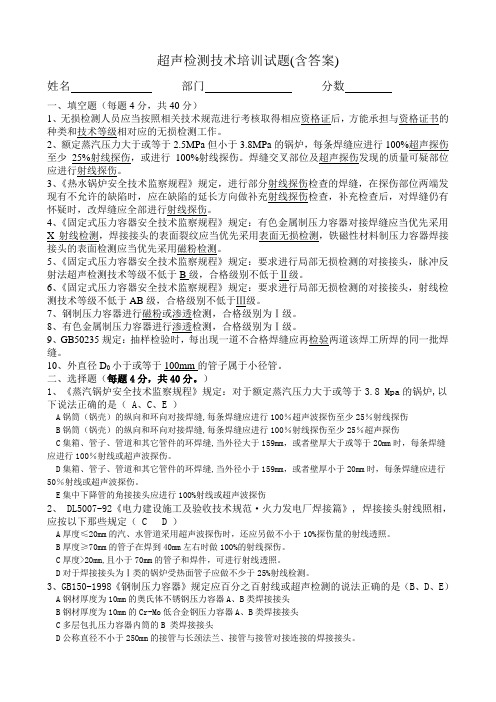
超声检测技术培训试题(含答案)姓名部门分数一、填空题(每题4分,共40分)1、无损检测人员应当按照相关技术规范进行考核取得相应资格证后,方能承担与资格证书的种类和技术等级相对应的无损检测工作。
2、额定蒸汽压力大于或等于2.5MPa但小于3.8MPa的锅炉,每条焊缝应进行100%超声探伤至少25%射线探伤,或进行100%射线探伤。
焊缝交叉部位及超声探伤发现的质量可疑部位应进行射线探伤。
3、《热水锅炉安全技术监察规程》规定,进行部分射线探伤检查的焊缝,在探伤部位两端发现有不允许的缺陷时,应在缺陷的延长方向做补充射线探伤检查,补充检查后,对焊缝仍有怀疑时,改焊缝应全部进行射线探伤。
4、《固定式压力容器安全技术监察规程》规定:有色金属制压力容器对接焊缝应当优先采用X射线检测,焊接接头的表面裂纹应当优先采用表面无损检测,铁磁性材料制压力容器焊接接头的表面检测应当优先采用磁粉检测。
5、《固定式压力容器安全技术监察规程》规定:要求进行局部无损检测的对接接头,脉冲反射法超声检测技术等级不低于B级,合格级别不低于Ⅱ级。
6、《固定式压力容器安全技术监察规程》规定:要求进行局部无损检测的对接接头,射线检测技术等级不低于AB级,合格级别不低于Ⅲ级。
7、钢制压力容器进行磁粉或渗透检测,合格级别为Ⅰ级。
8、有色金属制压力容器进行渗透检测,合格级别为Ⅰ级。
9、GB50235规定:抽样检验时,每出现一道不合格焊缝应再检验两道该焊工所焊的同一批焊缝。
10、外直径D0小于或等于100mm的管子属于小径管。
二、选择题(每题4分,共40分。
)1、《蒸汽锅炉安全技术监察规程》规定:对于额定蒸汽压力大于或等于3.8 Mpa的锅炉,以下说法正确的是( A、C、E )A锅筒(锅壳)的纵向和环向对接焊缝,每条焊缝应进行100%超声波探伤至少25%射线探伤B锅筒(锅壳)的纵向和环向对接焊缝,每条焊缝应进行100%射线探伤至少25%超声探伤C集箱、管子、管道和其它管件的环焊缝,当外径大于159mm,或者壁厚大于或等于20mm时,每条焊缝应进行100%射线或超声波探伤。
超声波检测培训资料
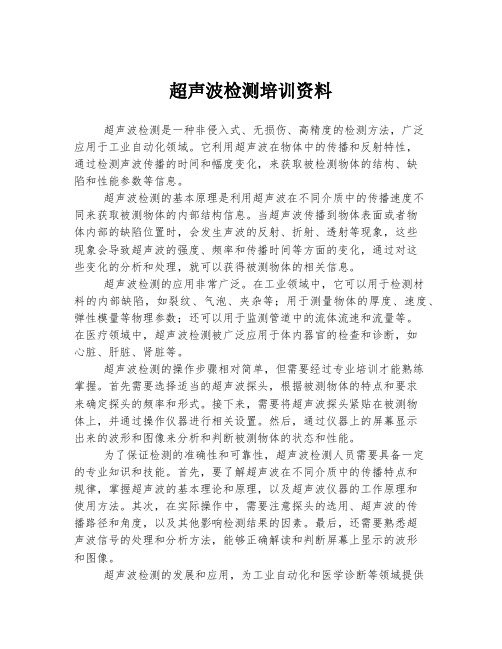
超声波检测培训资料超声波检测是一种非侵入式、无损伤、高精度的检测方法,广泛应用于工业自动化领域。
它利用超声波在物体中的传播和反射特性,通过检测声波传播的时间和幅度变化,来获取被检测物体的结构、缺陷和性能参数等信息。
超声波检测的基本原理是利用超声波在不同介质中的传播速度不同来获取被测物体的内部结构信息。
当超声波传播到物体表面或者物体内部的缺陷位置时,会发生声波的反射、折射、透射等现象,这些现象会导致超声波的强度、频率和传播时间等方面的变化,通过对这些变化的分析和处理,就可以获得被测物体的相关信息。
超声波检测的应用非常广泛。
在工业领域中,它可以用于检测材料的内部缺陷,如裂纹、气泡、夹杂等;用于测量物体的厚度、速度、弹性模量等物理参数;还可以用于监测管道中的流体流速和流量等。
在医疗领域中,超声波检测被广泛应用于体内器官的检查和诊断,如心脏、肝脏、肾脏等。
超声波检测的操作步骤相对简单,但需要经过专业培训才能熟练掌握。
首先需要选择适当的超声波探头,根据被测物体的特点和要求来确定探头的频率和形式。
接下来,需要将超声波探头紧贴在被测物体上,并通过操作仪器进行相关设置。
然后,通过仪器上的屏幕显示出来的波形和图像来分析和判断被测物体的状态和性能。
为了保证检测的准确性和可靠性,超声波检测人员需要具备一定的专业知识和技能。
首先,要了解超声波在不同介质中的传播特点和规律,掌握超声波的基本理论和原理,以及超声波仪器的工作原理和使用方法。
其次,在实际操作中,需要注意探头的选用、超声波的传播路径和角度,以及其他影响检测结果的因素。
最后,还需要熟悉超声波信号的处理和分析方法,能够正确解读和判断屏幕上显示的波形和图像。
超声波检测的发展和应用,为工业自动化和医学诊断等领域提供了重要的技术手段。
通过超声波检测,可以及时发现物体的缺陷和问题,提前作出相应的处理和修复,从而大大提高了生产效率和产品质量。
同时,它还可以帮助医生快速准确地诊断疾病,为患者提供精准治疗和救治。
超声波探伤讲义(内部培训资料)

超声波探伤讲义(内部培训资料)超声波探伤讲义(内部培训资料)一、概述超声波探伤是一种常用的非破坏性检测技术,广泛应用于工业领域。
本讲义将介绍超声波探伤的原理、设备、操作流程以及常见的应用场景。
二、原理超声波探伤利用材料中超声波的传播和反射特性来检测物体内部的缺陷。
超声波在材料中传播时,遇到界面或缺陷时会发生折射和反射,通过接收和分析反射信号,可以判断缺陷的位置和性质。
三、设备1. 超声波探伤仪:包括发射装置、接收装置、控制系统等。
2. 控制台:用于调节探伤仪的参数和显示检测结果。
3. 传感器:将超声波信号传输到被检物体表面,并接收反射信号。
四、操作流程1. 准备工作:确认探伤区域、选择合适的传感器和探头,并对设备进行检查和校准。
2. 设置参数:根据被检材料的性质和缺陷类型,调节控制台上的参数,如频率、增益等。
3. 扫描检测:将传感器沿被检物体表面平稳移动,保持一定的检测速度,记录反射信号。
4. 数据分析:通过控制台或计算机软件,对采集到的数据进行分析和处理,判断是否存在缺陷。
5. 结果评估:根据分析结果,评估被检物体的质量并作出相应的判定。
五、应用场景1. 金属材料检测:超声波探伤被广泛应用于金属材料的检测,如焊接接头、铸件、锻件等。
2. 管道检测:可以通过超声波探伤检测管道内部的腐蚀、裂纹等缺陷,保证管道的安全运行。
3. 轴承检测:超声波探伤可以检测轴承内部的裂纹、磨损等问题,预防故障和损坏。
4. 建筑结构检测:超声波探伤可用于检测混凝土结构中的空洞、裂缝等缺陷,确保建筑物的安全性。
六、注意事项1. 操作人员需经过专业培训,并持证上岗。
2. 检测前需对设备进行检查和校准,确保其正常工作。
3. 根据被检材料的性质和缺陷类型,选择合适的探头和参数设置。
4. 操作过程中需保持传感器与被检物体表面的贴合度,并保持恒定的扫描速度。
5. 分析结果需结合其他检测方法或实际应用情况进行综合评估。
七、总结超声波探伤技术是一种重要的非破坏性检测方法,具有广泛的应用前景。
超声检测技术(Ⅱ级PPT讲稿)
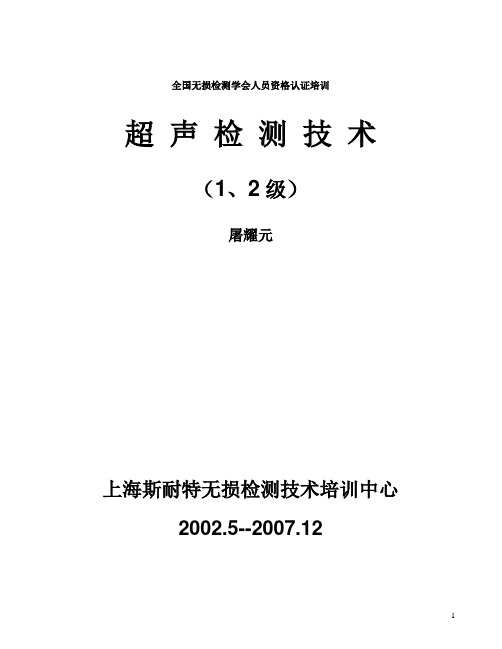
全国无损检测学会人员资格认证培训超声检测技术(1、2级)屠耀元上海斯耐特无损检测技术培训中心2002.5--2007.12第一章概论1.1 无损检测概论一、无损检测的定义:不破坏材料的外形和性能的情况下,检测该材料的内部结构(组织与不连续)和性能,该技术称为无损检测。
英文全称:Non Destructive Testing (NDT)二、常用无损检测方法(1)射线检测:Radiographic Testing (RT)检测对象类型:金属;非金属。
焊缝;铸件。
检测缺陷类型:裂纹;气孔;未焊透;未融合;夹渣;疏松;冷隔等。
(2)超声检测:Ultrasonic Testing (UT)超声波的本质:机械波,它是由于机械振动在弹性介质中引起的波动过程,例如水波、声波、超声波等超声波的类型:纵波和横波表面波(瑞利波)、板波超声波的产生:仪器、探头超声波与工件的接触:耦合剂超声检测:原理超声波检测原理:探头发射的超声波通过耦合剂在工件中传播,遇到缺陷时反射回来被探头接收。
根据反射回波在荧屏上的位置和波辐高低判断缺陷的大小和位置。
检测对象类型:金属;非金属。
焊缝;板件;管件;锻件;铸件。
检测缺陷类型:面缺陷;体缺陷。
定性困难。
射线检测与超声检测比较:A. 射线检测优点是缺陷显示直观;定量、定位准确;可以定性;检测结果可以长期保留。
缺点是检测周期长;成本高;大厚度工件检测比较困难。
B. 超声检测优点是检测周期短;成本低;大厚度工件检测方便;缺点是不能显示缺陷形状;不能精确定量,不能定性。
(3)磁粉检测: Magnetic Testing (MT)漏磁场:铁磁材料磁化时磁力线由于折射而迤出到材料表面所形成的磁场称为漏磁场剩磁:铁磁材料磁化时所具有的磁性在磁化电流取消后继续存在的性质称为剩磁铁磁材料在磁场中被磁化后,缺陷处产生的漏磁场吸附磁粉而形成磁痕。
磁痕的长度、位置、形状反映了缺陷的状态。
磁粉检测技术的特点:检测表面和近表面缺陷;铁磁材料;常用检测方法:剩磁法;连续法。
无损检测(超声波)培训考核习题集

超声波检测培训考核习题集共:676 题其中:是非题175 题选择题279 题问答题103 题计算题119 题一、是非题1.1受迫振动的频率等于策动力的频率.( )1.2波只能在弹性介质中产生和传播.( )1.3由于机械波是机械振动产生的,所以波动频率等于振动频率.( )1.4由于机械波是由机械振动产生的,所以波长等于振幅.( )1.5传声介质的弹性模量越大,密度越小,声速就越高.( )1.6材料组织不均匀会影响声速,所以对铸铁材料超声波探伤和测厚必须注意这一问题.( )1.7一般固体介质中的声速随温度升高而增大.( )1.8由端角反射率实试验结果推断,使用K≥1.5的探头探测单面焊焊缝根部未焊透缺陷,灵敏度较低,可能造成漏检.( )1.9超声波扩散衰减的大小与介质无关.( )1.10超声波的频率越高,传播速度越快.( )1.11介质能传播横波和表面波的必要条件是介质具有切变弹性模量.( )1.12频率相同的纵波,在水中的波长大于在钢中的波长.( )1.13既然水波能在水面传播,那么超声表面波也能沿液体表面传播.( )1.14因为超声波是由机械振动产生的,所以超声波在介质中的传播速度即为质点的振动速度.( )1.15如材质相同,细钢棒(直径<λ=与钢锻件中的声速相同、).( )1.16在同种固体材料中,纵、横波声速之比为常数.( )1.17水的温度升高时,超声波在水中的传播速度亦随着增加.( )1.18几乎所有的液体(水除外),其声速都随温度的升高而减小.( )1.19波的叠加原理说明,几列波在同一介质中传播并相遇时,都可以合成一个波继续传播.( )1.20介质中形成驻波时,相邻两波节或波腹之间的距离是一个波长.( )1.21具有一定能量的声束,在铝中要比在钢中传播的更远.( )1.22材料中应力会影响超声波传播速度,在拉应力时声速减小,在压应力时声速增大,根据这一特性,可用超声波测量材料的内应力.( )1.23材料的声阻抗越大,超声波衰减越大.( )1.24平面波垂直入射到界面上,入射声压等于透射声压和反射声压之和.( )1.25平面波垂直入射到界面上,入射能量等于透射能量和反射能量之和.( )1.26超声波的扩散衰减与波型,声程和传声介质、晶粒度有关.( )1.27对同一材料而言,横波的衰减系数比纵波大得多.( )1.28界面上入射声束的折射角等于反射角.( )1.29当声束以一定角度入射到不同介质的界面上,会发生波形转换.( )1.30在同一固体材料中,传播纵、横波时声阻抗不一样.( )1.31声阻抗是衡量介质声学特性的重要参数,温度变化对材料的声阻抗无任何影响.( ) 1.32超声波垂直入射到平界面时,声强反射率与声强透射率之和等于 1.( )1.33超声波垂直入射到异质界面时,界面一侧的总声压等于另一侧的总声压.( )1.34超声波垂直入射到Z2 >Z1的界面时,声压透射率大于1,说明界面有增强声压的作用.( )1.35超声波垂直入射到异质界面时,声压往复透射率与声强透射率在数值上相等.( ) 1.36超声波垂直入射时,界面两侧介质声阻抗差愈小,声压往复透射率愈低.( )1.37当钢中的气隙(如裂纹)厚度一定时,超声波频率增加,反射波高也随着增加.( ) 1.38超声波倾斜入射到异质界面时,同种波型的反射角等于折射角.( )1.39超声波倾斜入射到异质界面时,同种波型的折射角总大于入射角.( )1.40超声波以10 角入射至水/钢界面时,反射角等于10 .( )1.41超声波入射至水/钢界面时,第一临界角约为14.5 .( )1.42第二介质中折射的横波平行于界面时的纵波入射角为第一临界角.( )1.43如果有机玻璃/铝界面的第一临界角大于有机玻璃/钢界面的第一临界角,则前者的第二临界角也一定大于后者.( )1.44只有当第一介质为固体介质时,才会有第三临界角.( )1.45横波斜入射至钢/空气界面时,入射角在30 左右时,横波声压反射率最低.( )1.46超声波入射到C1<C2的凹曲面时,其透过波发射.( )1.47超声波入射到C1>C2的凸曲面时,其透过波集聚.( )1.48以有机玻璃作声透镜的水浸聚焦滩头,有机玻璃/水界面为凹曲面.( )1.49介质的声阻抗愈大,引起的超声波的衰减愈严重.( )1.50聚焦探头辐射的声波,在材质中的衰减小.( )1.51超声波探伤中所指的衰减仅为材料对声波的吸收作用.( )1.52超声平面波不存在材质衰减.( )2.1超声波频率越高,近场区的长度也就越大.( )2.2对同一直探头来说,在钢中的近场强度比在水中的近场强度大.( )2.3聚焦探头的焦距应小于近场长度.( )2.4探头频率越高,声束扩散角越小、2.5超声波探伤的实际声场中的声束轴线上不存在声压为零的点.( )2.6声束指向性不仅与频率有关,而且与波型有关.( )2.7超声波的波长越长,声束扩散角就越大,发现小缺陷的能力也就越强.( )2.8因为超声波会扩散衰减,所以检测应尽可能在其近场区进行.( )2.9因为近场区内有多哥声压为零的点,所以探伤时近场区缺陷往往会漏检.( )2.10如超声波频率不变,晶片面积越大,超声场的近场长度越短.( )2.11面积相同,频率相同的圆晶片和方晶片,超声场的近场长度一样长.( )2.12面积相同,频率相同的圆晶片和方晶片,其声束指向角亦相同.( )2.13超声场的近场长度愈短,声束指向性愈好.( )2.14声波辐射的超声波,总是在声束中心轴线上的声压为最高.( )2.15声波辐射的超声波的能量主要集中在主声束内.( )2.16探伤采用低频是为了改善声束指向性,提高探伤灵敏度.( )2.17超声场中不同截面上的声压分布规律是一致的.( )2.18在超声场的未扩散区,可将声源辐射的超声波看成平面波,平均声压不随距离增加而改变.( )2.19斜角探伤横波声场中假想声源的面积大于实际声源面积.( )2.20频率和晶片尺寸相同时,横波声束指向性比纵波好.( )2.21圆晶片斜探头的上指向角小于下指向角.( )2.22如斜探头入射点到晶片的距离不变,入射点到假想声源的距离随入射角的增加而减小.( )2.23200mm处ф4长横孔的回波声压比100mm处ф2长横孔的回波声压低.( )2.24球孔的回波声压随距离的变化规律与平底孔相同.( )2.25同声程理想大平面与平底孔回波声压的比值岁频率的提高而减小.( )2.26轴类工件外圆径向探伤时,曲底面回波声压比同声程理想大平面相同.( )2.27对空心圆柱体在内孔探伤时,曲底面回波声压比同声程大平面低.( )3.1超声波探伤中,发射超声波是利用正压电效应,接收超声波是利用逆压电效应.( ) 3.2增益100dB就是信号强度放大100倍.( )3.3与锆钛酸铅想比,石英作为压电材料有性能稳定、机电藕合系数高、压电转换能量损失小等优点.( )3.4与普通探头相比,聚焦探头的分辨力较高.( )3.5使用聚焦透镜能提高灵敏度和分辨力,但减小了探测范围.( )3.6点聚焦探头比线聚焦探头灵敏度高.( )3.7双晶探头只能用于纵波检测.( )3.8B型显示能够展现工件内缺陷的埋藏深度.( )3.9C型显示能展现工件中缺陷的长度和宽度,但不能展现深度.( )3.10通用AVG曲线采用的距离是以近场长度为单位的归一化距离,适用于不同规格的探头.( )3.11在通用AVG曲线上,可直接查得缺陷的实际声程和当量尺寸.( )3.12A型显示探伤仪,利用D.G.S曲线板可直观显示缺陷的当量大小和缺陷深度.( ) 3.13电磁超声波探头的优点之一是换能效率高,灵敏度高.( )3.14多通道探伤仪是由多个或多对探头同时工作的探伤仪.( )3.15探伤仪中的发射电路亦称为触发电路.( )3.16探伤仪中的发射电路亦可产生几百伏到上千伏的电脉冲去激励探头晶片振动.( ) 3.17探伤仪的扫描电路即为控制探头在工件探伤面上扫查的电路.( )3.18探伤仪发射电路中的阻尼电阻的阻值愈大,发射强度愈弱.( )3.19调节探伤仪“深度细调”旋钮时,可连续改变扫描线扫描速度.( )3.20调节探伤仪“抑制”旋钮时,抑制越大,仪器动态范围越大.( )3.21调节探伤仪“延迟”按钮时,扫描线上回波信号间的距离也将随之改变.( )3.22不同压电晶体材料中声速不一样,因此不同压电材料的频率常数也不相同.( )3.23不同压电材料的频率常数不一样,因此用不同压电材料制作的探头其标称频率不可能相同.( )3.24压电晶片的压电应变常数(d33)大,则说明该晶片接收性能好.( )3.25压电晶片的压电电压常数(g33)大,则说明该晶片接收性能好.( )Q,减少机械能损耗.( ) 3.26探头中压电晶片背面加吸收块是为了提高机械品质因素m3.27工件表面比较粗糙时,为防止探头磨损和保护晶片,宜选用硬保护膜.( )3.28斜探头楔块前部和上部开消声槽的目的是使声波反射回晶片处,减少声能损失.( ) 3.29由于水中只能传播纵波,所以水浸探头只能进行纵波探伤.( )3.30双晶直探头倾角越大,交点离探测面距离愈远,复盖区愈大.( )3.31有机玻璃声透镜水浸聚焦探头,透镜曲率半径愈大,焦距愈大.( )3.32利用IIW试块上ф50mm孔与两侧面的距离,仅能测定直探头盲区的大致范围.( ) 3.33当斜探头对准IIW试块上R50曲面时,荧光屏上的多次反射回波是等距离.( )3.34中心切槽的半圆试块,其反射特点是多次回波总是等距离出现.( )3.35与IIW试块相比CSK-1A试块的优点之一是可以测定斜探头分辨力.( )3.36调节探伤仪的“水平”旋钮,将会改变仪器的水平线性.( )3.37测定仪器的“动态范围”时,应将仪器的“抑制”、“深度补偿”旋钮置于“关”的位置.( )3.38盲区与始波宽度是同一概念.( )3.39测定组合灵敏度时,可先调节仪器的“抑制”按钮,使点噪声电平≤10%,再进行测试.( )3.40测定“始波宽度”时,应将仪器的灵敏度调至最大.( )3.41为提高分辨力,在满足探伤灵敏度要求情况下,仪器的发射强度应尽量调得低一些.( )3.42在数字化智能超声波探伤仪中,脉冲重复频率又称为采样频率.( )3.43双晶探头主要应用于近表面缺陷的探测.( )3.44温度对斜探头折射角有影响,当温度升高时,折射角将变大.( )3.45目前使用最广泛的测厚仪是共振式测厚仪.( )3.46在钢中折射角为60º的斜探头,用于探测铝时,其折射角将变大.( )3.47“发射脉冲宽度”就是指发射脉冲的持续时间.( )3.48软保护膜探头可减少粗糙表面对探伤的影响.( )3.49脉冲发射式和穿透式探伤,使用的探头式同一类型、3.50声束指向角较小且声束截面较窄的探头称作窄脉冲探头.( )4.1在液浸式检测中,返回探头的声能还不到最初值的1%.( )4.2垂直探伤时探伤面的粗糙度对反射波高的影响比斜角探伤严重.( )4.3超声脉冲通过材料后,其中心频率将变低.( )4.4串列法探伤适用于检查垂直于谈侧面的平面缺陷.( )4.5“灵敏度”意味着发现小缺陷的能力,因此超声波探伤灵敏度越高越好.( )4.6所谓“幻影回波”,是由于探伤频率过高或材料晶粒粗大引起的 .( )4.7当量法用来测量大于声束截面的缺陷的尺寸.( )4.8半波高度发用来测量大小于声束截面的缺陷的尺寸.( )4.9串列式双探头法探伤即为穿透法.( )4.10厚焊缝采用串列法扫描时,如焊缝余高磨平,则不存在死区.( )4.11曲面工件探伤时,探伤面曲率半径愈大,耦合效果愈好.( )4.12实际探伤中,为提高扫描速度减少的干扰,应将探伤灵敏度适当降低.( )4.13采用当量法确定的缺陷尺寸一般小于缺陷的实际尺寸.( )4.14只有当工件中缺陷在各个方向的尺寸均大于声束截面时,才能采用测长法确定缺陷长度.( )4.15绝对灵敏度法测量缺陷指示长度时,测长灵敏度高,测得的缺陷长度大.( )4.16当工件内存在较大的内应力时,将使超声波的传播速度及方向发生变化.( )4.17超声波倾斜入射至缺陷表面时,缺陷反射波高随入射角的增大而增高.( )5.1钢板探伤时,通常只根据缺陷波情况判定缺陷.( )5.2当钢板中缺陷大于声束截面时,由于缺陷多次反射波互相干涉容易出现“叠加效应”.( )5.3厚钢板探伤中,若出现缺陷的多次反射波,说明缺陷的尺寸一定较大.( )5.4较薄钢板采用底波多次法探伤时,如出现“叠加效应”,说明钢板中缺陷尺寸一定很大.( )5.5复合钢板探伤时,可以从母材一侧探伤,也可从复合材料一侧探伤.( )5.6用板波法探测厚度5mm以下薄钢板时,不仅能检出内部缺陷,同时能检出表面缺陷.( ) 5.7钢管水浸聚焦法探伤时,不宜采用线聚焦探头探测较短缺陷.( )5.8采用水浸聚焦探头检测钢管时,声透镜的中心部分厚度应为λ/2的整数倍.( )5.10钢管水浸探伤时,水中加入适量活性剂是为了调节水的声阻抗,改善透声性.( ) 5.11钢管水浸探伤时,如钢管中无缺陷,荧光屏上只有始波和界面波.( )5.12用斜探头对大口径钢管作接触法周向探伤时,其跨距比同厚度平板大.( )6.1对轴类锻件探伤,一般来说以纵波直探头从径向探测效果最佳.( )6.2使用斜探头对轴类锻件作圆柱面轴向探测时,探头应用正反两个方向扫查.( )6.3对饼形锻件,采用直探头作径向探测时最佳的探伤方法.( )6.4调节锻件探伤灵敏度的底波法,其含义是锻件扫描过程中依据底波变化情况评定锻件质量等级.( )6.5锻件探伤中,如缺陷引起底波明显下降或消失时,说明锻件中存在较严重的缺陷.( ) 6.6锻件探伤时,如缺陷被探伤人员判定为白点,则应按密集缺陷评定锻件等级.( )6.7铸钢件超声波探伤,一般以纵波直探头为主.( )7.1焊缝横波探伤中,裂纹等危害性缺陷的反射波幅一般很高.( )7.2焊缝横波探伤中,如采用直射法,可不考虑结构反射、变型波等干扰回波的影响.( ) 7.3采用双探头串列法扫描焊缝时,位于焊缝深度方向任何部位的缺陷,其反射波均出现在荧光屏上同一位置.( )7.4焊缝探伤时所用斜探头,当楔块底面前部磨损较大时,其K值将变小.( )7.5焊缝横波探伤时常采用液态偶合剂,说明横波可以通过液态介质薄层.( )7.6当焊缝中的缺陷与声束成一定角度时,探测频率较高时,缺陷回波不易被探头接收.( )7.7窄脉冲聚焦探头的优点是能量集中,穿透力强,所以适合于奥氏体钢焊缝检测.( ) 7.8一般不采用从堆焊层一侧探测的方法检测堆焊层缺陷.( )7.9铝焊缝探伤应选用较高频率的横波专用斜探头.( )7.10裂缝探伤中,裂纹的回波比较尖锐,探头转动时,波很快消失.( )是非题答案1.1 ○ 1.2 × 1.3 ○ 1.4 × 1.5 ○1.6 ○ 1.7 × 1.8 ○ 1.9 ○ 1.10 ×1.11 ○ 1.12 × 1.13 × 1.14 × 1.15 ×1.16 ○ 1.17 × 1.18 ○ 1.19 × 1.20 ×1.21 × 1.22 ○ 1.23 × 1.24 × 1.25 ○1.26 × 1.27 ○ 1.28 × 1.29 ○ 1.30 ○1.31 × 1.32 ○ 1.33○ 1.34 × 1.35 ○1.36 × 1.37 ○ 1.38 × 1.39 × 1.40○1.41 × 1.42 × 1.43 × 1.44 ○ 1.45 ○1.46 × 1.47 ○ 1.48 × 1.49 × 1.50 ×1.51 × 1.52 ×2.1 ○ 2.2 × 2.3 ○ 2.4 ○ 2.5 ○2.6 ○ 2.7 × 2.8 × 2.9 × 2.10 ×2.11 ○ 2.12 × 2.13 × 2.14 ○ 2.15 ×2.16 × 2.17 × 2.18 ○ 2.19 × 2.20 ○2.21 × 2.22 ○ 2.23 ○ 2.24 ○ 2.25 ○2.26 ○ 2.27 ×3.1 × 3.2 × 3.3 × 3.4 ○ 3.5 ○3.6 ○ 3.7 × 3.8 ○ 3.9 ○ 3.10 ○3.11 × 3.12 ○ 3.13 × 3.14 × 3.15 ×3.16 ○ 3.17 × 3.18 × 3.19 ○ 3.20 ×3.21 × 3.22 ○ 3.23 × 3.24 × 3.25 ○3.26× 3.27 × 3.28 × 3.29 × 3.30 ×3.31 ○ 3.32 ○ 3.33 × 3.34 ○ 3.35 ○3.36 × 3.37 ○ 3.38 × 3.39 × 3.40 ×3.41 ○ 3.42 × 3.43 ○ 3.44 ○ 3.45 ×3.46 × 3.47 ○ 3.48 ○ 3.49 × 3.50 ×4.1 ○ 4.2 ○ 4.3 ○ 4.4 ○ 4.5 ×4.6 × 4.7 × 4.8 × 4.9 × 4.10 ×4.11 ○ 4.12 × 4.13 ○ 4.14 × 4.15 ○4.16 ○ 4.17 ×5.1 × 5.2 × 5.3 ○ 5.4 × 5.5 ○5.6 ○ 5.7 ○ 5.8 ○ 5.9 ○ 5.10 ×5.11 ○ 5.12 ○6.1 ○ 6.2 ○ 6.3 × 6.4 × 6.5 ○6.6 × 6.7 ○7.1 ○ 7.2 × 7.3 ○ 7.4 ○ 7.5 ×7.6 ○ 7.7 × 7.8 ○ 7.9 ○ 7.10 ×二、选择题1.1、以下关于谐振动的叙述,那一条是错误的A、谐振动就是质点在作匀速圆周运动、B、任何复杂振动都可视为多个谐振动的合成、C、在谐振动动中,质点在位移最大处受力最大,速度为零、D、在谐振动动中,质点在平衡位置速度大,受力为零、1.2、以下关于阻尼振动的叙述,那一条是错误的()A、阻尼使振动物体的能量逐渐减小、B、阻尼使振动物体的振幅逐渐减小、C、阻尼使振动物体的运动速率逐渐减小、D、阻尼使振动周期逐渐变长、1.3、超声波是频率超出人耳听觉的弹性机械波,其频率范围约为:()A、高于2万赫兹B、1-10MHZC、高于200HZD、0.25-15MHZ1.4、在金属材料的超声波探伤中,使用最多的频率范围是:()A、10-25MHZB、1-1000KHZC、1-5MHZD、大于20000MHZ1.5 机械波的波速取决于A、机械振动中质点的速度B、机械振动中质点的振幅C、机械振动中质点的振动频率D、弹性介质的特性1.6 在同种固体材料中,纵波声速C L横波声速C S表面波声速C R 之间的关系是:A、C R>C S>C LB、C S>C L>C R 、、C、 C L >C S>C RD、以上都不对1.7 在下列不同类型超声波中,哪种波的传播速度随频率的不同而改变A、表面波B、板波C、疏密波D、剪切波1.8 超声波如射到异质界面时,可能发生()A、反射B、折射C、波型转换D、以上都是1.9 超声波在介质中的传播速度与()有关、A、介质的弹性B、介质的密度C、超声波波型D、以上全部1.10 在同一固体材料中,纵、横波声速相比,与材料的()有关?A、密度B、弹性模量C、泊松比D、以上全部1.11质点振动方向垂直于波的传播方向的波是:()A、纵波B、横波C、表面波D、兰姆波1.12在流体中可传播:()A、纵波B、横波C、纵波、横波及表面波D、切变波1.13超声纵波、横波和表面波速度主要取决于:()A、频率B、传声介质的几何尺寸C、传声材料的弹性模量和密度D.以上全都不全面,须视具体情况而定1.14板波的速度主要取决于:()A、频率B、传声介质的几何尺寸C、传声材料的弹性模量和密度D. 以上全都不全面,须视具体情况而定1.15钢中超声纵波声速为590000cm/s,若频率为10MHZ则其波长:()A、59mmB、5.9mmC、0.59mmD、2.36mm1.16下面哪种超声波的波长最短()A、水中传播的2MHZ纵波B、钢中传播的2.5MHZ横波C、钢中传播的5MHZ纵波D、钢中传播的2MHZ表面波1.17一般认为表面波作用于物体的深度大约为()A、半个波长B、一个波长C、两个波长D、3.7个波长1.18 钢中表面波的能量大约在距表面多深的距离会降低到原来的1/25.( )A、五个波长B、一个波长C、1/10波长D、0.5波长1.19 脉冲反射法超声波探伤主要利用超声波传播过程中的()A、散射特性B、反射特性C、投射特性D、扩散特性1.20 超声波在弹性介质中传播时有()A、质点振动和质点移动B、质点振动和振动传递C、质点振动和能量传播D、B和C1.21超声波在弹性介质中的速度是()A、质点振动的速度B、声能的传播速度C、波长和传播时间的乘积D、以上都不是1.22若频率一定,下列哪种波型在固体弹性介质中传播的波长最短:()A、剪切波B、压缩波C、横波D、瑞利表面波1.23材料的声速和密度的乘积称为声阻抗,它将影响超声波()A、在传播时的材质衰减B、从一个介质到达另一个介质时在界面上的反射和投射C、在传播时的散射D、扩散角大小1.24 声阻抗是:()A、超声振动的参数B、界面的参数C、传声介质的参数D、以上都不对1.25 当超声纵波由水垂直射向钢时,其反射系数大于1,这意味着:()A、能量守恒定律在这里不起作用B、透射能量大于入射能量C、A与B都对D、以上都不对1.26 当超声纵波由钢垂直射向水时,其反射系数小于0,这意味着:()A、透射能量大于入射能量B、反射超声波振动相位与入射声波互成180ºC、超声波无法透入水中D、以上都不对1.27垂直入射于异质界面得超声波束得反射声压和透射声压:()A、与界面二边材料的声速有关B、与界面二边材料的密度有关C、与界面二边材料的声速有关D、与入射声波波型有关1.28 在液浸探伤中,哪种波会迅速衰减:()A、纵波B、横波C、表面波D、切变波1.29 超声波传播过程中,遇到尺寸与波长相当的障碍物时,将发生()A、只绕射,无反射B、既反射又绕射C、只反射无绕射D、以上都有可能1.30 在同一固体介质中,当分别传播纵、横波时,它的声阻抗将是( )A 、一样B 、传播横波时大C 、传播纵波时大D 、无法确定1.31 超声波垂直入射到异质界面时,反射波与透过波声能的分配比例取决于( )A 、界面两侧介质的声速B 、界面两侧介质的衰减系数C 、界面两侧介质的声阻抗D 、以上全部1.32在同一界面上,声强透过率T 与声压反射率r 之间的关系是()A 、T=r 2B 、T=1-r 2C 、T=1+rD 、 T=1-r1.33 在同一界面上,声强反射率R 与声强透过率T 之间的关系是()A 、R+T=1B 、T=1-RC 、R=1-TD 、以上全部1.34超声波倾斜入射至异质界面时,其传播方向的改变主要取决于()A 、界面两侧介质的声阻抗B 、界面两侧介质的声速C 、界面两侧介质衰减系数D 、以上全部1.35倾斜入射到异质界面的超声波束的反射声压与透射声压与哪一因素有关()A 、反射波波型B 、入射角度C 、界面两侧的声阻抗D 、以上都是1.36 纵波垂直入射到水浸法超声波探伤,若工件底面全反射,计算底面回波声压公式为( )A 、 122124()Z Z T Z Z =+B 、 2112Z Z T Z Z -=+ C 、 2122Z T Z Z =+ D 、 122124()Z Z T Z Z =+1.37一般地说,如果频率相同,则在粗晶材料中穿透能力最强的振动波型为:( )A、表面波B、纵波C、横波D、三种波型的穿透力相同1.38 不同振动频率,而在钢中有最高声速的波型是:()A、0.5MHZ的纵波B、2.5MHZ的横波C、10MHZ的爬波D、5MHZ的表面波1.39在水/钢界面上,水中入射角为17º,在钢中传播的主要振动波型为:()A、表面波B、横波C、纵波D、B和C1.40当超声纵波由有机玻璃以入射角15º射向钢界面时,可能存在:()A、反射纵波 B.反射横波 C.折射纵波和折射横波 D.以上都有1.41如果将用于钢的K2探头区探测铝(C Fe=3.23km/s,C AL=3.10km/s),则K值会()A、大于2B、小于2C、等于2D、以上都有1.42如果超声纵波由水以20º入射到钢界面,则在钢中横波折射角为:()A、约48ºB、约24ºC、 39ºD、以上都不对1.43第一临界角是:()A、折射纵波等于90º时的横波入射角B、折射横波等于90º时的纵波入射角C、折射纵波等于90º时的纵波入射角D、入射纵波接近90º时的折射角1.44第二临界角是:()A、折射纵波等于90º时的横波入射角B、折射横波等于90º时的纵波入射角C、折射纵波等于90º时的纵波入射角D、入射纵波接近90º时的折射角1.45要在工件中得到纯横波,探头入射角α必须:()A、大于第二临界角B、大于第一临界角C.在第一、第二临界角之间D.小于第二临界角1.46一般均要求斜探头楔块材料的纵波速度小于被检材料的纵波声速,因为只有这样才有可能:( )A 、在工件中得到纯横波B 、得到良好的声束指向性C 、实现声束聚焦D 、减少近场区的影响1.47纵波以20º入射角自水入射至钢中,下图中哪一个声束路径是正确的?( )SLLLLSLLLL1.48用入射角为52º的斜探头探测方钢,下图中哪一个声束路径是正确的?()A BC D1.49直探头纵波探测具有倾斜底面的锻钢件,下图中哪一个声束路径是正确的?()A B C1.50第一介质为有机玻璃(C L =2700m/s ),第二介质为铜(C L =4700m/s ,C S =2700m/s ),则第II 临界角为()A 、12700sin4700X α-= B 、12700sin 2300X α-= C 、12300sin 2700X α-= D 、以上都不对1.51用4MHZ 钢质保护膜直探头经甘油耦合后,对钢试件进行探测,若要能得到最佳透声效果,其耦合层厚度为(甘油C L =1920m/s )()A 、1.45mmB 、0.20mmC 、0.7375mmD 、0.24mm1.52用直探头以水为透声楔块使钢板对接焊缝中得到横波检测,此时探头声束轴线相 对于探测面的倾角范围为:( )A 、14.7o ~27.7o B 、62.3o ~75.3o C 、27.2o ~56.7oD 、不受限制1.53 有一不锈钢复合钢板,不锈钢复合层声阻抗Z1,基体钢板声阻抗Z2,今从钢板一侧以2.5MHZ直探头直接接触法探测,则界面上声压透射率公式为:()A、2112Z ZZ Z-+B、1212Z ZZ Z-+C、1122ZZ Z+D、2122ZZ Z+1.54 由材质衰减引起的超声波减弱db数等于:()A、衰减系数与声程的乘积B、衰减系数与深度的乘积C、seμ-(μ为衰减系数,S为声程) D、以上都不对1.55 超声波(活塞波)在非均匀介质中传播,引起声能衰减的原因是:()A、介质对超声波的吸收B、介质对超声波的散射C、声束扩散D、以上全部1.56 斜探头直接接触法探测钢板焊缝时,其横波:()A、在有机玻璃斜楔块中产生B、从晶片上直接产生C、在有机玻璃与耦合层界面上产生D、在耦合层与钢板界面上产生1.57 制作凹曲面的聚焦透镜时,若透镜材料声速为C1,第二透声介质声速为C2,则两者材料应满足如下关系:()A、C1>C2B、C1<C2C、C1=C2D、Z1=Z21.58 当聚焦探头声透镜的曲率半径增大时,透镜焦距将:()A.增大 B.不变 C.减少 D.以上都不对1.59 平面波在曲界面上透过情况,正确的图是:()A、 C1>C2B、 C1>C2C、C1<C2D、C1<C21.60 以下关于板波性质的叙述,哪条是错误的()A、按振动方向分,板波可分为SH波和兰姆波,探伤常用的是兰姆波B、板波声速不仅与介质特性有关,而且与板厚、频率有关C、板波声速包括相速度和群速度两个参数D、实际探伤应用时,只考虑相速度,无须考虑群速度1.61 由材料晶粒粗大而引起的衰减属于:()A、扩散衰减B、散射衰减C、吸收衰减D、以上都是1.62 与超声频率无关的衰减方式是()A、扩散衰减B、散射衰减C、吸收衰减D、以上都是1.63 下面有关材料衰减的叙述、哪句话是错误的:( )A、横波衰减比纵波严重B、衰减系数一般随材料的温度上升而增大C、当晶粒度大于波长1/10时对探伤有显著影响D、提高增益可完全克服衰减对探伤的影响2.1 波束扩散角是晶片尺寸和传播介质中声波波长的函数并且随()A、频率增加,晶片直径减少而减少B、频率或晶片直径减少而增大C、频率或晶片直径减少而减少D、频率增加,晶片直径减少而增大2.2 晶片直径D=20mm的直探头,在钢中测得其零辐射角为10o,该探头探测频率约为()A、2.5MHZB、5MHZC、4MHZD、2MHZ2.3 直径Ф12mm晶片5MHZ直探头在钢中的指向角是()A、5.6oB、3.5oC、6.8oD、24.6o2.4 Ф14mm,2.5MHZ直探头在钢中近场区为()A、27mmB、21mmC、38mmD、以上都不对。
超声波检测(UT) II级人员培训教材
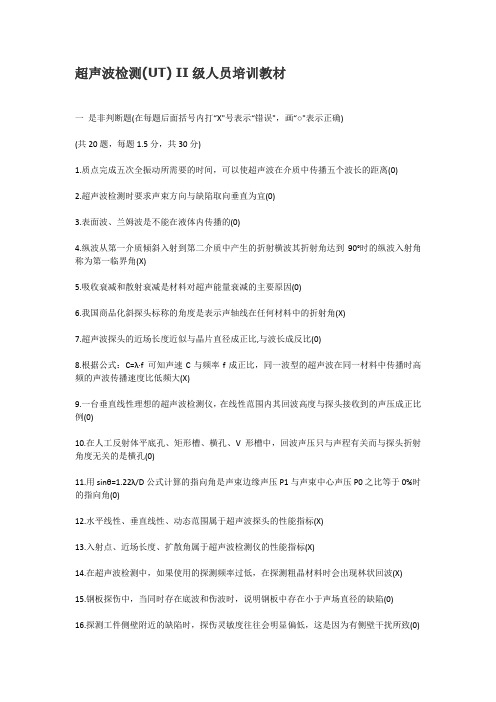
超声波检测(UT) II级人员培训教材一是非判断题(在每题后面括号内打“X"号表示“错误",画“○"表示正确)(共20题,每题1.5分,共30分)1.质点完成五次全振动所需要的时间,可以使超声波在介质中传播五个波长的距离(0)2.超声波检测时要求声束方向与缺陷取向垂直为宜(0)3.表面波、兰姆波是不能在液体内传播的(0)4.纵波从第一介质倾斜入射到第二介质中产生的折射横波其折射角达到90°时的纵波入射角称为第一临界角(X)5.吸收衰减和散射衰减是材料对超声能量衰减的主要原因(0)6.我国商品化斜探头标称的角度是表示声轴线在任何材料中的折射角(X)7.超声波探头的近场长度近似与晶片直径成正比,与波长成反比(0)8.根据公式:C=λ·f 可知声速C与频率f成正比,同一波型的超声波在同一材料中传播时高频的声波传播速度比低频大(X)9.一台垂直线性理想的超声波检测仪,在线性范围内其回波高度与探头接收到的声压成正比例(0)10.在人工反射体平底孔、矩形槽、横孔、V形槽中,回波声压只与声程有关而与探头折射角度无关的是横孔(0)11.用sinθ=1.22λ/D公式计算的指向角是声束边缘声压P1与声束中心声压P0之比等于0%时的指向角(0)12.水平线性、垂直线性、动态范围属于超声波探头的性能指标(X)13.入射点、近场长度、扩散角属于超声波检测仪的性能指标(X)14.在超声波检测中,如果使用的探测频率过低,在探测粗晶材料时会出现林状回波(X)15.钢板探伤中,当同时存在底波和伤波时,说明钢板中存在小于声场直径的缺陷(0)16.探测工件侧壁附近的缺陷时,探伤灵敏度往往会明显偏低,这是因为有侧壁干扰所致(0)17.耦合剂的用途是消除探头与工件之间的空气以利于超声波的透射(0)18.按照经典理论,超声波检测方法所能检测的最小缺陷尺寸大约是(λ/2)(0)19.按JB/T4730-2005.3标准检验钢板时,相邻间距为70mm的两个缺陷,第一缺陷指示面积为20cm2,指示长度为50mm,第二缺陷指示面积为25cm2,指示长度为75mm,则此张钢板(1x1m)为II级(0)20.外径400mm,内径300mm压力容器用低合金钢筒形锻件,可按JB/T4730-2005.3标准检验(X)二选择题(将认为正确的序号字母填入题后面的括号内,只能选择一个答案)(共30题,每题1.5分,共45分)1.工业超声波检测中,产生和接收超声波的方法,最经常利用的是某些晶体的(c)a.电磁效应b.磁致伸缩效应c.压电效应d.磁敏效应2.对于无损检测技术资格等级人员,有权独立判定检测结果并签发检测报告的是(d)a.高级人员b.中级人员c.初级人员d.a和be.以上都可以3.焊缝中常见的缺陷是下面哪一组?(b)a.裂纹,气孔,夹渣,白点和疏松b.未熔合,气孔,未焊透,夹渣和裂纹c.气孔,夹渣,未焊透,折叠和缩孔d.裂纹,未焊透,未熔合,分层和咬边4. GB/T 9445-1999无损检测人员资格鉴定与认证规定的证书一次有效期最长为(b)a.3年b.5年c.10年d.15年5.下列材料中声速最低的是(a):a.空气 b.水 c.铝 d.不锈钢6.一般来说,在频率一定的情况下,在给定的材料中,横波探测缺陷要比纵波灵敏,这是因为(a)a.横波比纵波的波长短b.在材料中横波不易扩散c.横波质点振动的方向比缺陷更为灵敏d.横波比纵波的波长长7.超过人耳听觉范围的声波称为超声波,它属于(c)a.电磁波b.光波c.机械波d.微波8.波长λ、声速C、频率f之间的关系是(a):a.λ=c/f b.λ=f/c c.c=f/λ9.如果超声波频率增加,则一定直径晶片的声束扩散角将(a)a.减少b.保持不变c.增大d.随波长均匀变化10.有一个5P20x10 45°的探头,有机玻璃楔块内声速为2730m/s,被检材料(碳钢)中的声速为3230m/s,求入射角α的公式为(b)a.sinα=(3230/2730)•sin45°b.α=sin-1(3230/2730)•sin 45°c.tgα=(3230/2730)•Sin45°11.为减小超声波通过介质时的衰减和避免林状回波,宜采用(d)进行探伤a.高频率、横波b.较低频率、横波c.高频率、纵波d.较低频率、纵波12.缺陷反射能量的大小取决于(d)a.缺陷尺寸b.缺陷方位c.缺陷类型d.以上都是13.靠近探头的缺陷不一定都能探测到,因为有(c)a.声束扩散b.材质衰减c.仪器阻塞效应d.折射14.超声波在介质中的传播速度主要取决于(d)a.脉冲宽度b.频率c.探头直径d.超声波通过的材质和波型15.声束在何处开始超过晶片直径?(b):a.1.67倍近场b.三倍近场c.从晶片位置开始16.超声波检测中对探伤仪的定标(校准时基线)操作是为了(c)a.评定缺陷大小b.判断缺陷性质c.确定缺陷位置d.测量缺陷长度17.用对比试块对缺陷作定量评定,已知工件中缺陷埋藏深度为22mm,验收标准为Φ1.2mm平底孔当量,则应选用同材料对比试块中的(c)进行比较:a.Φ3-20mmb.Φ2-25mmc.Φ1.2-25mmd.Φ1.2-20mm18.锻件探伤中,如果材料的晶粒粗大,通常会引起(d)a.底波降低或消失b.有较高的"噪声"显示c.使声波穿透力降低d.以上全部19.采用试块对比法探伤时,由于工件表面粗糙,会造成声波传播的损耗,其表面补偿应为(c):a.2dB b.4dB c.用实验方法测定的补偿dB值d.对第一种材料任意规定的补偿dB值20.检验钢材用的商品化60°斜探头,探测铝材时,其折射角(a)a.大于60°b.等于60°c.小于60°d.以上都可能21.为使经折射透入第二介质的超声波只有横波,纵波在第一介质的入射角应(c)a.大于第二临界角b.小于第一临界角c.在第一和第二临界角之间d.在第二和第三临界角之间22.用纵波直探头探伤,找到缺陷最大回波後,缺陷的中心位置(d)a.在任何情况下都位于探头中心正下方b.位于探头中心左下方c.位于探头中心右下方d.未必位于探头中心正下方23.超声波检测条件的主要考虑因素是(f)a.工作频率b.探头和仪器参数c.耦合条件与状态d.探测面e.材质衰减f.以上都是24.锻件探伤中,荧光屏上出现"林状(丛状)波"时,是由于(d)a.工件中有小而密集缺陷b.工件中有局部晶粒粗大区域c.工件中有疏松缺陷d.以上都有可能25.铸钢件超声波探伤的主要困难是(d)a.材料晶粒粗大b.声速不均匀c.声阻抗变化大d.以上全部26.当用双晶直探头在管材上测厚时,应使探头隔声层的方向与管材轴向(c)a.平行b.成45°角c.垂直d.成60°角27.按JB/T4730-2005.3标准规定,在一张钢板上有一指示长度为55mm的缺陷,其指示面积为20cm2,则该张钢板为(d) a.I级 b.II级 c.不合格 d.其级别评定要视位置而定28.按JB/T4730-2005.3标准规定,缺陷指示长度小于10毫米时,其长度应记为(d)a.8毫米b.6毫米c.3毫米d.5毫米29.按JB/T4730-2005.3标准规定,焊缝超声波探伤时,扫查灵敏度应不低于(b)a.定量线b.最大声程处的评定线c.判废线d.Φ2线30.JB/T4730-2005.3标准中对钢锻件进行质量等级分类的依据是(d)a.单个缺陷当量直径b.缺陷引起的底波降低量c.密集区缺陷占检测总面积百分比d.以上都作为独立的等级分别使用三问答题(共5题,每题2分,共10分)1. 什么叫“无损检测"?无损检测的目的是什么?常用的无损检测方法有哪些?答:在不破坏产品的形状、结构和性能的情况下,为了了解产品及各种结构物材料的质量、状态、性能及内部结构所进行的各种检测叫做无损检测;无损检测的目的是:改进制造工艺、降低制造成本、提高产品的可靠性、保证设备的安全运行。
超声波检测学习培训材料

工业领域的应用
01
02
03
材料无损检测
使用超声波对金属、非金 属等材料进行内部缺陷、 裂纹、夹杂等无损检测, 确保产品质量和安全。
厚度测量
通过超声波测量金属板、 塑料板等材料的厚度,实 现快速、准确的非接触式 测量。
液位检测
利用超声波在液体中的传 播特性,实现液位的实时 监测和控制。
医学领域的应用
用于模拟被检测对象的材料和 缺陷,需根据实验需求选择合
适的试块。
其他辅助设备
如电源线、连接线、探头夹持 器等。
实验步骤与操作规范
开机与预热
按照仪器说明书要求开机, 并进行必要的预热操作。
涂抹耦合剂
在试块表面均匀涂抹耦合 剂,以改善超声波的传播
效果。
发射超声波
按下发射按钮,发射超声 波信号。
设置参数
随着人工智能技术的不断发展,超声波检测设备的智能化 程度将不断提高,如自动识别、自动分析等功能将成为未 来超声波检测设备的重要特点。
对个人职业发展的意义和价值
提升职业竞争力
通过学习和掌握超声波检测技术,可以增强个人在无损检测领域的 职业竞争力,为未来的职业发展打下坚实基础。
拓展职业发展空间
随着超声波检测技术的不断发展,其应用领域也将不断拓展,这为 个人职业发展提供了更多的发展空间和机会。
等,提高了分析问题、解决问题的能力。
未来发展趋势与展望
技术创新
随着科技的不断进步,超声波检测技术将不断创新,如更 高频率、更高分辨率的超声波检测技术将不断涌现。
应用领域拓展
随着超声波检测技术的不断发展,其应用领域也将不断拓 展,如生物医学、材料科学等新兴领域将成为超声波检测 技术的重要应用领域。
全自动相控阵超声检测培训-2024鲜版

正确安装探头并进行校准,确保探头的位置和角 度准确。
2024/3/27
开始检测
将探头放置在待检测材料上,启动检测系统,开始 进行检测。
数据处理与分析
对检测数据进行处理和分析,提取有用的信息, 如缺陷的位置、大小和性质等。
结果显示与记录
将检测结果以图像或数据的形式显示在显示器上,并进 行记录和保存。
采用A型显示方式观察超声信号,通过调节增益和时间 基线等参数,使信号清晰可辨。
结合数据分析软件,对采集到的超声数据进行处理和分 析,提取特征参数并生成检测报告。
2024/3/27
21
实验数据分析与处理
数据分析
2024/3/27
对采集到的超声信号进行预处理,如滤波、降噪等,以提高信噪比。
利用时域、频域和时频域分析方法,提取超声信号中的特征信息,如幅 度、频率、相位等。
26
技术应用过程与效果
技术应用过程
全自动相控阵超声检测技术通过发射超声波并接收其反射信号来检测物体内部的缺陷。该技术利用相控阵技术控 制超声波的发射和接收,实现对复杂结构的全面、高效检测。
技术应用效果
全自动相控阵超声检测技术具有高精度、高效率、高可靠性等优点。它能够准确识别出物体内部的微小缺陷,并 提供详细的缺陷信息,为后续的维修和处理提供重要依据。同时,该技术还能够实现对复杂结构的全面检测,提 高了检测的效率和准确性。
02
03
04
在进行实验前,务必熟悉全自 动相控阵超声检测系统的操作
手册和安全规范。
确保实验环境符合设备要求, 如温度、湿度等。
在实验过程中,注意防止电磁 干扰和机械振动对检测结果的
影响。
18
实验操作步骤与方法
超声波检测理论基础培训课件
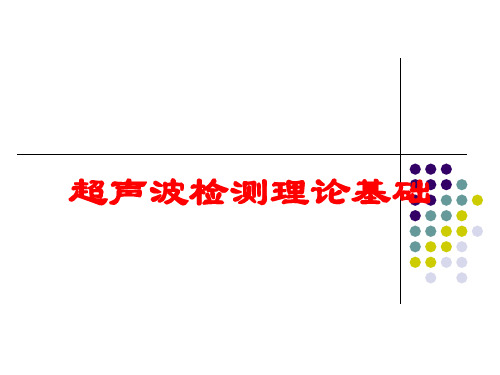
2/12/2024
超声波检测理论基础
5
1.2.3超声检测方法的分类
1、按原理:脉冲反射法、衍射时差法、穿透法、共 振法
2、按显示方式:A型显示、超声成像显示 3、按波型:纵波法、横波法、表面波法、板波法、
爬波法 4、按探头数目:单探头法、双探头法、多探头法 5、按探头与工件的接触方式:接触法;液浸法、电
3、表面波R:当介质表面受到交变应力作用时,产生 沿介质表面传播的波。
瑞利1887年首提,又称瑞利波。介质表面的质点作椭 圆运动。椭圆的长轴垂直于波的传播方向,短轴平行 于波的传播方向,介质质点的椭圆振动可视为纵波与 横波的合成。瑞利首先对这种波给予了理论上的说明, 因此表面波又称为瑞利波(Rayleigh wave),常用R 表示。
2/12/2024
超声波检测理论基础
11
机械波的主要物理量
1、声速c:单位时间内,超声波在介质中传播的距离; 超声波的速度就是声音的速度,即声在空气(15℃)中
的速度是340米/秒,只不过它们的频率不同而已 ;超 声波在20 ℃的钢中是5 900米/秒;在铝中的传播速度 为5100米/秒。 2、频率f:单位时间内,超声波在介质中任一给定点 所通过完整波的个数; 3、波长λ:声波在传播时,同一波线上相邻两个相位 相同的质点之间的距离;
向平行的波。 压缩波 疏密波 承受压缩或拉伸 应力即可传播
2/12/2024
超声波检测理论基础
14
2.2.1 按波型分类
2、横波S:介质中质点的振动方向和波的传 播方向相互垂直的波。
切变波 剪切波 能承受剪切 应力才能传播
2/12/2024ຫໍສະໝຸດ 超声波检测理论基础15
2.2.1 按波型分类
- 1、下载文档前请自行甄别文档内容的完整性,平台不提供额外的编辑、内容补充、找答案等附加服务。
- 2、"仅部分预览"的文档,不可在线预览部分如存在完整性等问题,可反馈申请退款(可完整预览的文档不适用该条件!)。
- 3、如文档侵犯您的权益,请联系客服反馈,我们会尽快为您处理(人工客服工作时间:9:00-18:30)。
Training materials USTUTS培训材料1.Basic Principles of Ultrasonic Testing. 超声波检测(UT)的基本原理Ultrasonic Testing (UT) uses high frequency sound energy to conduct examinations and make measurements. Ultrasonic inspection can be used for flaw detection/evaluation, dimensional measurements, material characterization, and more.UT是用高频声音能量来检测和测量的。
超声波检测能用于缺陷的检测和评估,尺寸的测量、材料的特性和其他。
Ultrasonic Inspection is a very useful and versatile NDT method. Some of the advantages of ultrasonic inspection that are often cited include:超声波检测是很好用并且多功能的NDT方法。
下面是它的一些优点:•It is sensitive to both surface and subsurface discontinuities.•对表面和亚表面的不连续性都很灵敏。
•The depth of penetration for flaw detection or measurement is superior to other NDT methods.•缺陷检测和测量的深度方面优于其他的检测方法。
•Only single-sided access is needed when the pulse-echo technique is used.•当用回波技术时,只需要单边。
•It is highly accurate in determining reflector position and estimating size and shape. •确定检测缺陷位置和测量大小和形状时非常精确。
•Minimal part preparation is required.•只需要非常小的样品。
•Electronic equipment provides instantaneous results.•电子设备可以提供瞬间结果。
•Detailed images can be produced with automated systems.•可以自动产生详细的图像。
•It has other uses, such as thickness measurement, in addition to flaw detection.•其他功能,除了缺陷的检测还有厚度的测量等。
2.Wave Propagation. 波的传播Ultrasonic testing is based on time-varying deformations or vibrations in materials, which is generally referred to as acoustics. In solids, sound waves can propagate in four principle modes that are based on the way the particles oscillate. Sound can propagate as longitudinal waves, shear waves, surface waves, and in thin materials as plate waves. Longitudinal and shear waves are the two modes of propagation most widely used in ultrasonic testing.超声波的检测是基于声波在物料上产生随时间的变化的变形和震动。
在固体中,声波基于离子震荡有四种传播模式:即可以传播纵波、横波、表面波和薄板板波。
纵波和横波是超声波探伤主要使用的两种模式。
In longitudinal waves, the oscillations occur in the longitudinal direction or the direction of wave propagation. Since compressional and dilational forces are active in these waves, they are also called pressure or compressional waves. They are also sometimes called density waves because their particle density fluctuates as they move. Compression waves can be generated in liquids, as well as solids because the energy travels through the atomic structure by a series of comparison and expansion (rarefaction) movements.在纵波中,震荡发生在纵向或波传播的方向,由于压缩和扩张力激活了这些波,它们也叫压力波或压缩波,有时也称密度波,因为当它们移动时,它们的离子密度也在波动。
压缩波在液体和固体中可以被激发,因为能量是经过原子结构用一系列的压缩和扩张而传递的。
In the transverse or shear wave, the particles oscillate at a right angle or transverse to the direction of propagation. Shear waves require an acoustically solid material for effective propagation, and therefore, are not effectively propagated in materials such as liquids or gasses. Shear waves are relatively weak when compared to longitudinal waves. In fact, shear waves are usually generated in materials using some of the energy from longitudinal waves. 在横波或剪切波中,离子震荡是沿直角度或垂直于传播方向进行的。
剪切波的传播需要一种很好的声学传播材料,因此,它在液体或玻璃中是不能有效传播的。
横波相对纵波较弱。
实际上,在材料中横波的激发通常也是用纵波的能量实现的。
3.Modes of Sound Wave Propagation. 声波的传播模式In solids, molecules can support vibrations in other directions, hence, a number of different types of sound waves are possible. Waves can be characterized in space by oscillatory patterns that are capable of maintaining their shape and propagating in a stable manner. The propagation of waves is often described in terms of what are called “wave modes.”在固体中,分子能支持在其它方向的震动,因此,声波的不同形式是可能的。
波在太空传播的特性是维持原有的形状和以稳定的方式传播。
波的传播经常用“波的模式”来描述。
As mentioned previously, longitudinal and transverse (shear) waves are most often used in ultrasonic inspection. However, at surfaces and interfaces, various types of elliptical or complex vibrations of the particles make other waves possible. Some of these wave modes such as Rayleigh and Lamb waves are also useful for ultrasonic inspection.如前所述,纵波和横波是最经常使用的在超声波检测中。
然而,在表面和内表面,不规则的结构和复杂的离子运动也有产生其他波形的可能。
像瑞利波和兰姆波在超声波检测中也是使用的。
The table below summarizes many, but not all, of the wave modes possible in solids.下面表格中是一部分波的模式:Wave Types in Solids 固体内波形Particle Vibrations 离子震荡方向Longitudinal 纵波Parallel to wave direction 平行波的传播方向 Transverse (Shear) 横波Perpendicular to wave direction 垂直波的传播方向Surface - Rayleigh 表面瑞利波 Elliptical orbit - symmetrical mode 椭圆轨道-对称 Plate Wave – Lamb 板波- 兰姆波 Component perpendicular to surface (extensionalwave) 分量垂直于表面Plate Wave – Love 板波-拉乌波 Parallel to plane layer, perpendicular to wave direction平行于平面层,垂直于波的方向Stoneley (Leaky Rayleigh Waves) 斯通利波 (漏瑞利波)Wave guided along interface 波沿界面传播Sezawa 波 Antisymmetric mode 反对称模式Surface (or Rayleigh) waves travel the surface of a relatively thick solid material penetrating to a depth of one wavelength. Surface waves combine both a longitudinal and transverse motion to create an elliptic orbit motion as shown in the image and animation below. The major axis of the ellipse is perpendicular to the surface of the solid. As the depth of an individual atom from the surface increases the width of its elliptical motion decreases. Surface waves are generated when a longitudinal wave intersects a surface near the second critical angle and they travel at avelocity between .87 and .95 of a shear wave. Rayleigh waves are useful because they are very sensitive to surface defects (and other surface features) and they follow the surface aroundcurves. Because of this, Rayleigh waves can be used to inspect areas that other waves might have difficulty reaching.表面波(或瑞利波)是在相对厚的材料表面大约一个波长的深度传播的播。
